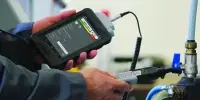The idea of utilizing AI to forecast an individual’s health later in life is exciting, and it has enormous promise for individualized healthcare. However, it is critical to recognize that effectively predicting future health outcomes is a hard endeavor with numerous problems and restrictions to consider.
We will soon be able to anticipate our risk of acquiring significant health disorders later in life by pressing a button, thanks to artificial intelligence. AAC, or abdominal aortic calcification, is a calcification that can form inside the walls of the abdominal aorta and predicts your risk of getting cardiovascular disease events such as heart attacks and stroke.
It also predicts your risk of falls, fractures, and dementia in old age. AAC can be detected using conventional bone density machine scans used to check osteoporosis. However, highly experienced specialist readers are required to analyze the photos, which might take between 5 and 15 minutes each image.
This is notable as these are the individuals with the greatest extent of disease and highest risk of fatal and nonfatal cardiovascular events and all-cause mortality. While there is still work to be done to improve the software’s accuracy compared to human readings, these results are from our version 1.0 algorithm, and we have already significantly improved the results with our more recent versions.
Professor Lewis
However, researchers from ECU’s School of Science and School of Medical and Health Sciences have cooperated to build software that can analyze scans much, much faster: around 60,000 photos in a single day.
Associate Professor Joshua Lewis, a researcher and Heart Foundation Future Leader Fellow, stated that this large increase in efficiency will be critical for the broad use of AAC in research and helping people avoid developing health problems later in life.
“Because these images and automated scores can be acquired quickly and easily during bone density testing,” he said, “this may lead to new approaches in the future for early cardiovascular disease detection and disease monitoring during routine clinical practice.”

Saving a LOT of time
The findings were the product of a worldwide collaboration involving ECU, the University of Washington, the University of Minnesota, Southampton, the University of Manitoba, the Marcus Institute for Aging Research, and Hebrew SeniorLife Harvard Medical School. Truly a multifaceted global effort.
Though it is not the first algorithm devised to measure AAC from these photos, the study is the largest of its kind, was based on the most regularly used bone density machine models, and is the first to be validated in a real-world context utilizing images acquired as part of routine bone density testing.
It saw more than 5000 images analysed by experts and the team’s software. After comparing the results, the expert and software arrived at the same conclusion for the extent of AAC (low, moderate or high) 80 per cent of the time — an impressive figure given it was the first version of the software. Importantly, only 3 per cent of people deemed to have high AAC levels were incorrectly diagnosed to have low levels by the software.
“This is notable as these are the individuals with the greatest extent of disease and highest risk of fatal and nonfatal cardiovascular events and all-cause mortality,” Professor Lewis said.
“While there is still work to be done to improve the software’s accuracy compared to human readings, these results are from our version 1.0 algorithm, and we have already significantly improved the results with our more recent versions.”
“Automated assessment of the presence and extent of AAC with similar accuracies to imaging specialists allows for large-scale screening for cardiovascular disease and other conditions – even before symptoms appear.” This will enable those who are at risk to make the essential lifestyle modifications much sooner, putting them in a better position to be healthy in their later years.”
















